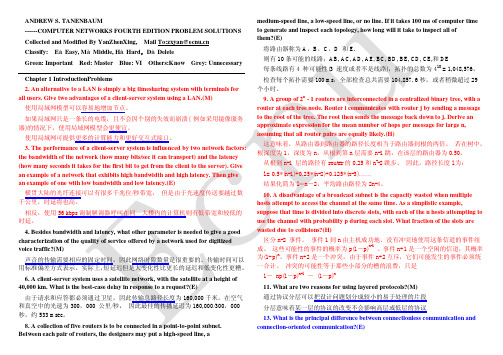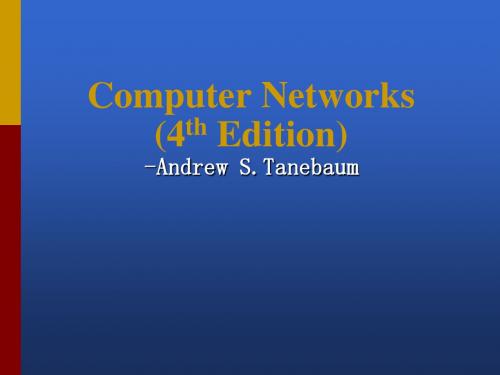计算机网络(第四版)英文原版1.1 Uses of Computer Networks
计算机网络(第四版)英文原版1.5 Example Networks

The Internet is not a network at all, but a vast collection of different networks that use certain common protocols and provide certain common services. It is an unusual system in that it was not planned by anyone and is not controlled by anyone. To better understand it, let us start from the beginning and see how it has developed and why. For a wonderful history of the Internet, John Naughton's (2000) book is highly recommended. It is one of those rare books that is not only fun to read, but also has 20 pages of ibid.'s and op. cit.'s for the serious historian. Some of the material below is based on this book.
For the first few years, ARPA tried to figure out what its mission should be, but in 1967, the attention of ARPA's then director, Larry Roberts, turned to networking. He contacted various experts to decide what to do. One of them, Wesley Clark, suggested building a packet-switched subnet, giving each host its own router, as illustrated in Fig. 1-10.
计算机网络(第四版)课后习题(英文)+习题答案(中英文)

damaged is p, what is the mean number of transmissions required to send a frame? Assume that acknowledgements are never lost.(M) 假设某帧传到第 k 次才传输成功, 起初 k-1 次传输皆尝试失败, 概率为 pk-1 , 第 k 次传输成功,概率为(1-p) ,则发送一帧成功的平均传输次数为:
1. a.
Which of the OSI layers handles each of the following: (a) Dividing the transmitted bit stream into frames.
b. (b) Determining which route through the subnet to use.(E) 把传输的比特流划分为帧——数据链路层 决定使用哪条路径通过子网——网络层. 19. If the unit exchanged at the data link level is called a frame and the unit exchanged at the network level is called a packet, do frames encapsulate packets or do packets encapsulate frames? Explain your answer.(E) 帧封装包。 当一个包到达数据链路层时,整个数据包,包括包头、数据及全部内 容,都用作帧的数据区。或者说,将整个包放进一个信封(帧)里面,( 如果能装入的 话)。 21. List two ways in which the OSI reference model and the TCP/IP reference model are the same. Now list two ways in which they differ.(M) 相似点:都是独立的协议栈的概念;层的功能也大体相似。 不同点:OSI 更好的区分了服务、接口和协议的概念,因此比 TCP/IP 具有更好的 隐藏性,能够比较容易的进行替换;OSI 是先有的模型的概念,然后再进行协议的 实现, 而 TCP/IP 是先有协议, 然后建立描述该协议的模型; 层次数量有差别; TCP/IP 没有会话层和表示层,OSI 不支持网络互连。OSI 在网络层支持无连接和面向连接 的通信, 而在传输层仅有面向连接的通信, 而 TCP/IP 在网络层仅有一种通信模式 (无 连接),但在传输层支持两种模式。 22. What is the main difference between TCP and UDP?(E) TCP 是面向连接的,而 UDP 是一种数据报服务。
计算机网络第4版(自顶向下方法)英文版ppt

connect adjacent nodes along communication path are links
wired links wireless links LANs
layer-2 packet is a frame,
encapsulates datagram
data-link layer has responsibility of transferring datagram from one node to adjacent node over a link
services:
error detection, correction sharing a broadcast channel: multiple access link layer addressing reliable data transfer, flow control: done!
each link protocol
tourist = datagram
provides different services
transport segment =
e.g., may or may not provide rdt over link
communication link transportation mode = link layer protocol travel agent = routing algorithm
5-11
Parity Checking
Single Bit Parity:
Detect single bit errors
Two Dimensional Bit Parity:
计算机网络(第四版)英文原版Chapter1.Introduction

计算机网络(第四版)英文原版Chapter1.Introduction[ Team LiB ]Chapter 1. IntroductionEach of the past three centuries has been dominated by a single technology. The 18th century was the era of the great mechanical systems accompanying the Industrial Revolution. The 19th century was the age of the steam engine. During the 20th century, the key technology was information gathering, processing, and distribution. Among other developments, we saw the installation of worldwide telephone networks, the invention of radio and television, the birth and unprecedented growth of the computer industry, and the launching of communication satellites.As a result of rapid technological progress, these areas are rapidly converging and the differences between collecting, transporting, storing, and processing information are quickly disappearing. Organizations with hundreds of offices spread over a wide geographical area routinely expect to be able to examine the current status of even their most remote outpost at the push of a button. As our ability to gather, process, and distribute information grows, the demand for ever more sophisticated information processing grows even faster.Although the computer industry is still young compared to other industries (e.g., automobiles and air transportation), computers have made spectacular progress in a short time. During the first two decades of their existence, computer systems were highly centralized, usually within a single large room. Not infrequently, this room had glass walls, through which visitorscould gawk at the great electronic wonder inside. A medium-sized company or university might have had one or two computers, while large institutions had at most a few dozen. The idea that within twenty years equally powerful computers smaller than postage stamps would be mass produced by the millions was pure science fiction.The merging of computers and communications has had a profound influence on the way computer systems are organized. The concept of the ''computer center'' as a room with a large computer to which users bring their work for processing is now totally obsolete. The old model of a single computer serving all of the organization's computational needs has been replaced by one in which a large number of separate but interconnected computers do the job. These systems are called computer networks. The design and organization of these networks are the subjects of this book.Throughout the book we will use the term ''computer network'' to mean a collection of autonomous computers interconnected by a single technology. Two computers are said to be interconnected if they are able to exchange information. The connection need not be via a copper wire; fiber optics, microwaves, infrared, and communication satellites can also be used. Networks come in many sizes, shapes and forms, as we will see later. Although it may sound strange to some people, neither the Internet nor the World Wide Web is a computer network. By the end of this book, it should be clear why. The quick answer is: the Internet is not a single network but a network of networks and the Web is a distributed system that runs on top of the Internet.There is considerable confusion in the literature between acomputer network and a distributed system. The key distinction is that in a distributed system, a collection of independent computers appears to its users as a single coherent system. Usually, it has a single model or paradigm that it presents to the users. Often a layer of software on top of the operating system, called middleware, is responsible for implementing this model. A well-known example of a distributed system is the World Wide Web, in which everything looks like a document (Web page).In a computer network, this coherence, model, and software are absent. Users are exposed to the actual machines, without any attempt by the system to make the machines look and act in a coherent way. If the machines have different hardware and different operating systems, that is fully visible to the users. If a user wants to run a program on a remote machine, he [] has to log onto that machine and run it there.[] ''He'' should be read as ''he or she'' throughout this book.In effect, a distributed system is a software system built on top of a network. The software gives it a high degree of cohesiveness and transparency. Thus, the distinction between a network and a distributed system lies with the software (especially the operating system), rather than with the hardware.Nevertheless, there is considerable overlap between the two subjects. For example, both distributed systems and computer networks need to move files around. The difference lies in who invokes the movement, the system or the user. Although this book primarily focuses on networks, many of the topics are also important in distributed systems. For more information about distributed systems, see (Tanenbaum and Van Steen, 2002).[ Team LiB ]。
计算机英语实用教程(第四版)目录介绍

计算机英语实用教程(第四版)目录介绍《计算机英语实用教程(第四版)》是2012年出版的一本图书,作者是刘兆毓、郑家农。
今天店铺在这里为大家介绍计算机英语实用教程(第四版)的目录介绍,欢迎大家阅读!计算机英语实用教程(第四版):基本信息出版社: 清华大学出版社; 第4版 (2010年9月1日)丛书名: 普通高等教育“十一五”国家级规划教材,计算机系列教材平装: 255页语种:英语, 简体中文开本: 16ISBN: 7302227977, 9787302227977条形码: 9787302227977商品尺寸: 25.8 x 18.2 x 1.2 cm商品重量: 422 g品牌: 清华大学出版社ASIN: B00426BSDQ计算机英语实用教程(第四版):编辑推荐《计算机英语实用教程(第4版)》:一共出版了4个版本,累计销售超50万册,得到了广泛的采用。
第四版吸收了反映当前最新技术和应用的内容,共由3部分组成:计算机硬件、计算机软件和计算机应用。
书中对一些较难翻译和理解的句子、单词进行了注释:每一节后面列出关键词汇,给出练习题;每一章后面还列出反映最新技术的一篇阅读材料以及相关词汇;以便提高读者阅读计算机英文文献的水平。
书后附有各节习题答案及译文,供读者参考。
《计算机英语实用教程(第四版)》在保留《计算机英语》基本结构的基础上,进行了课程内容的重新组合.使得读者在学时较少的情况下.同样能够掌握涉及计算机技术基础、系统和应用等各个方面的计算机英语知识。
内容相对精简,学习难度适当下调。
高校教师或读者可以根据自身的实际情况从以上两个版本中选择适合自己的教材。
计算机英语实用教程(第四版):目录参考译文第1章计算机硬件1.1 计算机组成1.2 什么是处理器1.3 存储系统1.4 输入输出(I/O)系统1.5 总线和控制器第2章计算机操作系统2.1 操作系统概述2.2 WINDOWSXP和VISTA2.3 UNIX和LINUX第3章个人计算机(PC)的使用3.1 选择和设置PC系统3.2 使用PC3.3 PC系统维护第4章计算机网络4.1 计算机网络的体系结构4.2 局域网(LAN)4.3 广域网(WAN)第5章因特网5.1 因特网概述5.2 与因特网连接5.3 万维网浏览器和服务器5.4 网络安全第6章因特网应用6.1 电子商务6.2 什么是企业资源计划ERP6.3 关于因特网电话第7章程序设计语言7.1 计算机语言概述7.2 BASIC和可视BASIC7.3 C、C++和C#7.4 标记和脚本语言第8章软件工程8.1 软件开发生命周期模型8.2 需求分析8.3 软件设计和测试8.4 软件维护第9章数据库及其应用9.1 数据库管理系统(DBMS)和管理信息系统(MIS) 9.2 数据库是如何工作的9.3 万维网(WEB)与数据库第10章办公自动化软件10.1 办公自动化软件基本知识10.2 0FFICE WORD 200710.3 0FFICE EXCEL 200710.4 0FFICE POWERPOINT 2007第11章计算机图形学与图像处理技术11.1 引言11.2 图形软件11.3 图像处理操作的层次结构11.4 数字图像文件格式第12章多媒体12.1 什么是多媒体12.2 多媒体的用途12.3 多媒体技术第13章现代工业自动化软件13.1 概述13.2 CAD、CAM和CAE的应用13.3 制造资源计划、MRP-Ⅱ及其他。
计算机网络(第四版)英文原版1.9 Summary

A factor in the delay of a store-and-forward packet-switching system is how long it takes to store and forward a packet through a switch. If switching time is 10 μsec, is this likely to be a major factor in the response of a client-server system where the client is in New York and the server is in California? Assume the propagation speed in copper and fiber to be 2/3 the speed of light in vacuum.
Well-known networks include the Internet, ATM networks, Ethernet, and the IEEE 802.11 wireless LAN. The Internet evolved from the ARPANET, to which other networks were added to form an internetwork. The present Internet is actually a collection of many thousands of networks, rather than a single network. What characterizes it is the use of the TCP/IP protocol stack throughout. ATM is widely used inside the telephone system for long-haul data traffic. Ethernet is the most popular LAN and is present in most large companies and universities. Finally, wireless LANs at surprisingly high speeds (up to 54 Mbps) are beginning to be widely deployed.
计算机网路(第四版)英文课件chp1

17
Business Applications of Networks (3)
The client-server model involves requests and replies.
18
Business Applications of Networks (4)
Email Ftp Web Videoconference E-commence
13
Chapter 1
Introduction
14
1.1 Uses of Computer Networks
Business Applications Home Applications
Mobile Users
Social Issues
15
1.1.1 Business Applications of Networks
8、网络安全(重点,后续课程学习)
• 密码学 • 对称加密算法 • 非对称加密算法 • Email, WWW 安全
12
Chapter 1 Outline
1.1 uses of computer networks 1.2 network hardware 1.3 network software 1.4 reference models 1.5 example networks 1.6 networks standardization
35
1.2.5 Home Network Categories
Computers (desktop PC, PDA, shared peripherals)
Entertainment (TV, DVD, VCR, camera, stereo, MP3) Telecomm (telephone, cell phone, intercom, fax) Appliances (microwave, fridge, clock, furnace, air co) Telemetry (utility meter, burglar alarm, babycam).
《计算机网络(第四版)》习题答案讲课稿

《计算机网络(第四版)》习题答案计算机网络(第四版) 习题答案第 1 章概述1-3 The performance of a client-server system is influenced by two network factors: the bandwidth of the network (how many bits/sec it can transport) and the latency (how many seconds it takes for the first bit to get from the client to the server). Give an example of a network that exhibits high bandwidth and high latency. Then give an example of one with low bandwidth and low latency.客户-服务器系统的性能会受到两个网络因素的影响:网络的带宽(每秒可以传输多少位数据)和延迟(将第一个数据位从客户端传送到服务器端需要多少秒时间)。
请给出一个网络的例子,它具有高带宽和高延迟。
然后再给出另一个网络的例子,它具有低带宽和低延迟。
答:横贯大陆的光纤连接可以有很多千兆位/秒带宽,但是由于光速度传送要越过数千公里,时延将也高。
相反,使用56 kbps调制解调器呼叫在同一大楼内的计算机则有低带宽和较低的时延。
1-4 Besides bandwidth and latency, what other parameter is needed to give a good characterization of the quality of service offered by a network used for digitized voice traffic?除了带宽和延迟以外,针对数字化的语音流量,想要让网络提供很好的服务质量,还需要哪个参数?声音的传输需要相应的固定时间,因此网络时隙数量是很重要的。
计算机网络技术基础-第4版-第1章 计算机网络概述

◦ 按网络中各个节点分布距离的长短,可以将计算机网络分 为三类,它们的特征参数见参表1-1。
第十一页,共31页。
1.3.1 按计算机网络的作用范围分类
◦在表1-1中,大致给出了各类网络的传输速率范围。总的规律是距离越长,速率越
低。
1. 局域网(local area network, LAN)
和互相访问的能力。
4.
Internet的技术特点
◦ ① 提供了建立在TCP/IP协议基础之上的WWW浏览服务。
◦ ② 采用了HTML、SMTP以及FTP等各种公开标准。
◦ ③ 其DNS域名服务器系统巧妙地解决了计算机和用户之间的 “地址”翻译问题。
第十七页,共31页。
1.4.2 Internet的组成与结构
(4) 分布式控制系统(distributed control
system,DCS)
(5) 电子数据交换系统(electronic data interchange system,EDI)
第十页,共31页。
1.3 计算机网络的分类
用于对计算机网络进行分类的标准很多。各种分类标准只能给出网络 某一方面的特征。
基本拓扑结构类型有:总线型、星型、环型、树 型和网状型等,参见图1-3。
第二十六页,共31页。
1.4 计算机网络拓扑结构
3.
网络拓扑的用途
网络拓扑的设计选型是计算机网络设计的第一步。网络
拓扑结构的选择将直接关系到网络的性能、系统可靠性、通 讯和投资费用等因素。
第二十七页,共31页。
1.6.2 通信子网信道类型和网络 拓扑结构的分类
的、世界范围的大型计算机互联网络。
2. 为什么要建立Internet?
计算机网络(第四版)英文原版1.2 Network Hardware

Broadcast networks have a single communication channel that is shared by all the machines on the network. Short messages, called packets in certain contexts, sent by any machine are received by all the others. An address field within the packet specifies the intended recipient. Upon receiving a packet, a machine checks the address field. If the packet is intended for the receiving machine, that machine processes the packet; if the packet is intended for some other machine, it is just ignored.
计算机网络(第4版)

1计算机网络(第4版)第一章概述谢希仁编著3第1章概述(有* 号的标题表示最基本的内容)1.1 计算机网络在信息时代中的作用1.2 计算机网络的发展过程*1.2.1 分组交换的产生*1.2.2 因特网时代*1.2.3 关于因特网的标准化工作1.2.4 计算机网络在我国的发展1.3 计算机网络的分类1.3.1 计算机网络的不同定义1.3.2 几种不同的分类方法4第1章概述(续)*1.4 计算机网络的主要性能指标1.4.1 带宽1.4.2 时延1.4.3 时延带宽积和往返时延5第1章概述(续)*1.5 计算机网络的体系结构1.5.1 计算机网络体系结构的形成1.5.2 划分层次的必要性1.5.3 具有五层协议的体系结构1.5.4 实体、协议、服务和服务访问点1.5.5 面向连接服务和无连接服务1.5.6 OSI 与TCP/IP 体系结构的比较*1.6 应用层的客户-服务器方式61.1 计算机网络在信息时代的作用21 世纪的一些重要特征就是数字化、网络化和信息化,它是一个以网络为核心的信息时代。
网络现已成为信息社会的命脉和发展知识经济的重要基础。
网络是指“三网”,即电信网络、有线电视网络和计算机网络。
发展最快的并起到核心作用的是计算机网络。
7因特网(Internet)的发展 进入20 世纪90 年代以后,以因特网为代表的计算机网络得到了飞速的发展。
已从最初的教育科研网络逐步发展成为商业网络。
已成为仅次于全球电话网的世界第二大网络。
8因特网是全球信息基础结构的雏形1993,美国提出建设NII (National Information Infrastructure 国家信息基础结构)--“信息高速公路” 1994,美国又提出建设GII (全球信息基础结构)--数字地球91.2 计算机网络的发展过程1.2.1 分组交换的产生是20 世纪60 年代美苏冷战时期的产物。
60 年代初,美国国防部领导的远景研究规划局ARPA (Advanced Research Project Agency) 提出要研制一种生存性(survivability)很强的网络。
计算机专业英语教程(第4版)全书译文

计算机专业英语教程(第4版)全书译文第1章:介绍计算机专业英语教程(第4版)全书是一本为计算机专业学生编写的英语教材。
本书旨在帮助学生提高英语水平,特别是在计算机领域的专业术语和技能方面。
本书是由经验丰富的专业人士编写的,其中包含了大量的案例研究和实践活动,以帮助学生更好地理解和应用所学知识。
第2章:计算机基础知识本章介绍了计算机的基础知识,包括计算机的组成部分、工作原理以及常见的计算机系统和网络。
通过学习这些内容,学生将能够了解计算机的主要组成部分以及它们之间的相互作用关系。
第3章:软件工程这一章节主要介绍了软件工程的基本概念和原则。
学生将学习软件生命周期、软件开发过程以及不同的软件工程方法和模型。
此外,本章还探讨了软件测试和质量保证的重要性。
第4章:数据库管理系统数据库管理系统是计算机专业中的重要主题。
本章介绍了数据库的基本概念和原理,包括数据库设计、数据模型和查询语言。
学生将通过学习数据库的相关内容,了解数据库在计算机领域中的应用以及其重要性。
第5章:计算机网络计算机网络是现代计算机技术中的关键领域。
本章讲解了计算机网络的基本概念、协议和技术,包括局域网、广域网和互联网。
学生将通过学习计算机网络的知识,了解网络通信的原理和实现方式,并掌握网络管理和安全方面的基本技能。
第6章:人工智能人工智能是计算机科学中的前沿领域,对计算机专业学生来说具有重要的意义。
本章介绍了人工智能的基本概念、算法和应用领域。
学生将通过学习人工智能的知识,了解智能系统的模型和设计原理,以及在现实生活中的实际应用。
第7章:计算机图形学计算机图形学是计算机专业的重要分支之一。
本章介绍了计算机图形学的基本原理和技术,包括图像处理、渲染和动画等方面。
学生将通过学习计算机图形学的知识,了解图形图像的生成和处理过程,掌握图形设计和开发的基本技能。
第8章:计算机安全计算机安全是计算机专业中的一个重要议题。
本章主要介绍了计算机安全的基本概念和技术,包括身份认证、访问控制和网络安全等方面。
《计算机网络》谢希仁(第四版)第01章

(packet)。分组又称为“包”,而分组的首部也可称为
“包头”。分组交换的特征是基于标记(label-based)。 不先建立连接而随时可发送数据的连网方式,称为 无 连接的(connectionless)。
分组交换
发送端
数 据 首部
在发送端把要发送的报文分隔为较短的数据块 每个块增加带有控制信息的首部构成分组(包) 依次把各分组发送到接收端 接收端剥去首部,抽出数据部分,还原成报文
换网是 以网络为中心 ,主机和终端都处在网络的外围,
如图1-6(b)所示。用户通过分组交换网可共享连接在网
接这些交换机的链路组成,如图1-4(a)所示。图1-4(b)
和图1-4(a)的表示方法是一样的,但强调了结点交换机 具有多个端口的概念。 图中H1 ~ H6都是可进行通信的计算机,但在计算 机网络中常称它们为主机(host)。在ARPANET建网初
期,分组交换网中的结点交换机曾被称为接口报文处
理机IMP (Interface Message Processor)。
报文
11010011101 • • • • • • • • 00101001110
数 据 分组
首部
数 据 分组
首部 发送 在前
分组
发 送
数 据 首部
发 送
数 据 首部
发 送
数 据
首部
接收端
数 据 数 据 11010011101 • • •数 • •据 • • • 00101001110
分组交换网由若干个结点交换机(node switch)和连
这里所说的网络是指电信网络(主要的业务是电话, 但也有其他业务,如传真、数据等)、有线电视网络 (即单向电视节目的传送网络,但现已开始逐渐向双向 传输网络改造)和计算机网络。这三种网络通常简称为 “三网”。 进入20世纪90年代以来,以因特网(Internet)为代 表的计算机网络的发展速度十分迅猛,已从最初的教
Chapter1_Computer Networks and the Internet——第4版

1.1 什么是因特网?-小结
具体构成描述
构成Internet的基本硬件和软件组件
服务描述
Internet是一种能为分布式应用程序提供服 务的网络基础设施
协议
定义了在两个或多个通信实体之间交换的 报文格式和次序,以及在报文传输和/或接 收或其他事件方面所采取的动作
你好
几点了
2:00
<file>
3 什么是协议?
网络协议:
1.1 ? 什 接收、发送消息的实体不是人,而是在 host中的硬件和软件实体 么 是 因特网中的所有活动都受协议的制 因 约 特 协议定义了在两个或多个通信实体之间 网 交换的报文格式和次序,以及在报文传 输和/或接收或其他事件方面所采取的 动作
边缘路由器(edge router) :从源主机到目的主机 路径上的第一个路由器
1.2
分类
住宅接入:Residential access 公司接入:Company access 无线接入:wireless access 注意:
•接入网的带宽
•共享/专用
School of Computer Science & Technology 30
7 School of Computer Science & Technology
1 具体构成描述
1.1 什 么 是 因 特 网 ?
端系统通常通过分组交换机 (packet switches)间接地连接在一 起。
路由器(Router)和链路层交换机 (Link-layer switch) 根据分组首部字段的值通过网络转发分组
Introduction
计算机网络(双语) C1-x_4

1.1 Uses of Computer rks
• Business Applications • Home Applications • Mobile Users
1.2 Network Hardware
• There is no generally accepted taxonomy into which all computer networks fit, but two dimensions stand out as important:
1.3 Network Software
• Protocol Hierarchies • Design Issues for the Layers • Connection-Oriented and Connectionless Services • The Relationship of Services to Protocols
Design Issues for the Layers
• • • • • Addressing Error Control Flow Control Multiplexing Routing
Services:Connections or Not
• Connection-oriented service
– transmission technology
• Broadcast links • Point-to-point links
– Scale
• • • • LAN MAN WAN Internetworks
Types of transmission technology
• Broadcast network:
Information for the remote translator
计算机网络技术(第4版)

3 5.6常见的
Internet接入 方式
4
本章小结
5
习题
6.1网络应用概述 6.2 DNS服务
6.3 WWW服务 6.4 FTP服务
6.5邮件服务 6.6 DHCP服务
本章小结 习题
1
7.1 WLAN概念 及其协议标准
2
7.2 WLAN网络 拓扑结构
3
7.3 WLAN应用
4
7.4 WLAN常见 设备
03
9.3网络扫 描工具的使 用
04
9.4网络监 听工具 Wireshar k的使用
06
9.6拒绝服 务攻击
05
9.5木马的 配置与防范
1
9.7计算机病 毒防治
2
9.8 PGP加密/ 解密系统
3 9.9 CCProxy
代理防火墙软 件的使用
4
本章小结
5
习题
10.1网络互联基础
10.2网络传输介质 的使用
12.1综合实训网络 拓扑结构图
12.3综合实训项目 实施
本章小结
习题
作者介绍
这是《计算机网络技术(第4版)》的读书笔记模板,暂无该书作者的介绍。
读书笔记
这是《计算机网络技术(第4版)》的读书笔记模板,可以替换为自己的心得。
精彩摘录
这是《计算机网络技术(第4版)》的读书笔记模板,可以替换为自己的精彩内容摘录。
计算机网络技术(第4版)
读书笔记模板
01 思维导图
03 目录分析 05 读书笔记
目录
02 内容摘要 04 作者介绍 06 精彩摘录
思维导图
本书关键字分析思维导图
实践
结构
技术
计算机网络与因特网第四版英文版教学设计

计算机网络与因特网第四版英文版教学设计
1. 课程介绍
本课程旨在介绍计算机网络及其在因特网中的应用。
包括硬件和软件方面的实现,网络协议、编程技术和管理技术的学习。
通过学习本课程,学生将对计算机网络中的基本概念、协议和实用技术有深刻的理解,具备设计和维护计算机网络的基本能力。
2. 教学目标
2.1 知识目标
•理解计算机网络的基本概念和架构
•熟悉网络协议的运作原理
•掌握网络安全和管理的基本技术和策略
•熟悉各种网络应用的实现原理和技术
2.2 能力目标
•能够设计并搭建局域网
•能够分析和解决网络故障
•能够开发网络应用程序
2.3 思想品德目标
•培养学生遵守网络道德规范的意识
•培养学生爱护网络环境的意识
•培养学生合作与创新精神
1。
计算机网络(第四版)英文原版1.7MetricUnits

计算机网络(第四版)英文原版1.7MetricUnits [ Team LiB ]1.7 Metric UnitsTo avoid any confusion, it is worth stating explicitly that in this book, as in computer science in general, metric units are used instead of traditional English units (the furlong-stone-fortnight system). The principal metric prefixes are listed in Fig. 1-39. The prefixes are typically abbreviated by their first letters, with the units greater than 1 capitalized (KB, MB, etc.). One exception (for historical reasons) is kbps for kilobits/sec. Thus, a 1-Mbps communication line transmits 106 bits/sec and a 100 psec (or 100 ps) clock ticks every 10-10 seconds. Since milli and micro both begin with the letter ''m,'' a choice had to be made. Normally, ''m'' is for milli and ''μ'' (the Greek letter mu) is for micro.Figure 1-39. The principal metric prefixes.It is also worth pointing out that for measuring memory, disk, file, and database sizes, in common industry practice, the units have slightly different meanings. There, kilo means 210 (1024) rather than 103 (1000) because memories are always a power of two. Thus, a 1-KB memory contains 1024 bytes, not 1000 bytes. Similarly, a 1-MB memory contains 220 (1,048,576) bytes, a 1-GB memory contains 230 (1,073,741,824) bytes, and a 1-TB database contains 240 (1,099,511,627,776) bytes. However, a 1-kbps communication line transmits 1000 bits per second and a 10-Mbps LAN runs at 10,000,000 bits/sec because these speeds are not powers of two. Unfortunately, many people tend to mix upthese two systems, especially for disk sizes. To avoid ambiguity, in this book, we will use the symbols KB, MB, and GB for 210, 220, and 230 bytes, respectively, and the symbols kbps, Mbps, and Gbps for 103, 106, and 109 bits/sec, respectively.[ Team LiB ]。
- 1、下载文档前请自行甄别文档内容的完整性,平台不提供额外的编辑、内容补充、找答案等附加服务。
- 2、"仅部分预览"的文档,不可在线预览部分如存在完整性等问题,可反馈申请退款(可完整预览的文档不适用该条件!)。
- 3、如文档侵犯您的权益,请联系客服反馈,我们会尽快为您处理(人工客服工作时间:9:00-18:30)。
1.1.1 Business Applications
Many companies have a substantial number of computers. For example, a company may have separate computers to monitor production, keep track of inventories, and do the payroll. Initially, each of these computers may have worked in isolation from the others, but at some point, management may have decided to connect them to be able to extract and correlate information about the entire company.
However, probably even more important than sharing physical resources such as printers, scanners, and CD burners, is sharing information. Every large and medium-sized company and many small companies are vitally dependent on computerized information. Most companies have customer records, inventories, accounts receivable, financial statements, tax information, and much more online. If all of its computers went down, a bank could not last more than five minutes. A modern manufacturing plant, with a computer-controlled assembly line, would not last even that long. Even a small travel agency or three-person law firm is now highly dependent on computer networks for allowing employees to access relevant information and documents instantly.
Figure 1-2. The client-server model involves requests and replies.
A second goal of setting up a computer network has to do with people rather than information or even computers. A computer network can provide a powerful communication medium among employees. Virtually every company that has two or more computers now has e-mail (electronic mail), which employees generally use for a great deal of daily communication. In fact, a common gripe around the water cooler is how much e-mail everyone has to deal with, much of it meaningless because bosses have discovered that they can send the same (often content-free) message to all their subordinates at the push of a button.
Put in slightly more general form, the issue here is resource sharing, and the goal is to make all programs, equipment, and especially data available to anyone on the network without regard to the physical location of the resource and the user. An obvious and widespread example is having a group of office workers share a common printer. None of the individuals really needs a private printer, and a high-volume networked printer is often cheaper, faster, and easier to maintain than a large collection of individual printers.
If we look at the client-server model in detail, we see that two processes are involved, one on the client machine and one on the server machine. Communication takes the form of the client process sending a message over the network to the server process. The client process then waits for a reply message. When the server process gets the request, it performs the requested work or looks up the requested data and sends back a reply. These messages are shown in Fig. 1-2.
[ Team LiB ]
1.1 Uses of Computer Networks
Before we start to examine the technical issues in detail, it is worth devoting some time to pointing out why people are interested in computer networks and what they can be used for. After all, if nobody were interested in computer networks, few of them would be built. We will start with traditional uses at companies and for individuals and then move on to recent developments regarding mobile users and home networking.
In the simplest of terms, one can imagine a company's information system as consisting of one or more databases and some number of employees who need to access them remotely. In this model, the data are stored on powerful computers called servers. Often these are centrally housed and maintained by a system administrator. In contrast, the employees have simpler machines, called clients, on their desks, with which they access remote data, for example, to include in spreadsheets they are constructing. (Sometimes we will refer to the human user of the client machine as the ''client,'' but it should be clear from the context whether we mean the computer or its user.) The client and server machines are connected by a network, as illustrated in Fig. 1-1. Note that we have shown the network as a simple oval, without any detail. We will use this form when we mean a network in the abstract sense. When more detail is required, it will be provided.
